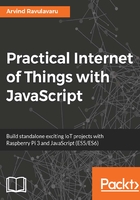
What this book covers
Chapter 1, The World of IoT, introduces you to the world of IoT. We will be looking at the history of IoT, identifying a few use cases, and getting a technical overview of what were are going to cover in this book.
Chapter 2, IoTFW.js - I, walks you through how to build a reference framework for developing IoT solutions using JavaScript. In this chapter, we cover the high-level architecture and get started with installing the required software. We will start with downloading the base application and stitching the Raspberry Pi together with the MQTTS broker and API engine.
Chapter 3, IoTFW.js - II, continues from where we left off in the previous chapter and completes the implementation of the API engine, web app, desktop app, and mobile app. At the end of this chapter, we implement a simple example with an LED and a temperature sensor, where instructions from the apps will turn the LED on/off and the value of the temperature sensor updates in real time.
Chapter 4, Smart Agriculture, talks about building a simple weather station using the reference architecture we have built. The weather station consists of four sensors, and using these we can monitor farm conditions. We will be making the required changes to the API engine, web app, desktop app, and mobile app.
Chapter 5, Smart Agriculture and Voice AI, shows how we can leverage the power of voice AI technology to build interesting IoT solutions. We are going to work with the smart weather station and add a one-channel mechanical relay to this setup. Then, using voice commands and Amazon Alexa, we are going to manage the weather station.
Chapter 6, Smart Wearable, talks about an interesting use case in the healthcare sector, postoperation patient care. Using a smart wearable device equipped with a simple accelerometer, one can easily detect whether a patient has fallen down. In this chapter, we build the required setup comment to gather the accelerometer values from the sensor.
Chapter 7, Smart Wearable and IFTTT, explains how the data collected from the accelerometer can be used to detect falls and at the same time notify the API engine. Using a popular concept named If This Then That (IFTTT)—we will be building our own rules engine, which will process predefined rules and take action accordingly. In our example, we are going to send an email to the patient's carer if a fall is detected.
Chapter 8, Raspberry Pi Image Streaming, shows how to take advantage of the Raspberry Pi camera module to build a real-time image streaming (MJPEG technology) solution to monitor your surroundings from anywhere in the world. We will also implement motion-based video capture to capture video when motion is detected.
Chapter 9, Smart Surveillance, walks you through the process of image recognition using Amazon's Rekognition platform. We will be capturing an image when motion is detected using the Raspberry Pi 3 camera module. Then, we will send this image to Amazon Rekognition platform to detect whether the image we have taken is of an intruder or of someone we know.